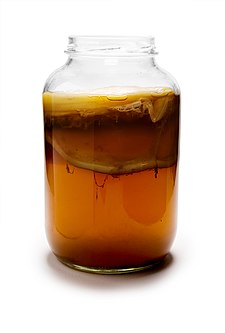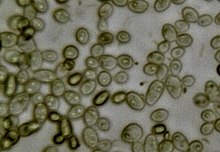Kombucha

Kombucha (Russian: chaynyy grib (чайный гриб), Chinese: chájūn (茶菌), Korean: beoseotcha (버섯차), Japanese: kōcha-kinoko (紅茶キノコ)), is a lightly effervescent fermented drink of sweetened black and/or green tea that is used as a functional food. It is produced by fermenting the tea using a symbiotic colony of bacteria and yeast, or "SCOBY". Although kombucha is claimed to have several beneficial effects on health, these claims are not supported by scientific evidence. Drinking kombucha has been linked, in rare cases, to serious side effects and deaths, and improper preparation can lead to contamination.[1]
History
Kombucha most likely originated in Northeast China or Manchuria, later spreading to east Russia sometime before 1910 and spread from there to Germany and Europe.[2] In Russian, the kombucha culture is called chainyy grib чайный гриб (literally "tea fungus/mushroom"), and the fermented drink is called chainyy grib, grib ("fungus; mushroom"), or chainyy kvas чайный квас ("tea kvass"). Kombucha was highly popular and seen as a health food in China in the 1950s and 1960s. Many families would grow kombucha at home.[citation needed] No historical records show use in ancient China or Japan (see history of tea in China and history of tea in Japan).[citation needed]
Chemical and biological properties

The kombucha culture is a symbiotic culture of bacteria and yeast (SCOBY), comprising Acetobacter (a genus of acetic acid bacteria) and one or more yeasts. These form a zoogleal mat. In Chinese, this microbial culture is called haomo in Cantonese, or jiaomu in Mandarin, (Chinese: 酵母; lit. 'fermentation mother'). It is also known as Manchurian Mushroom.
A kombucha culture may contain one or more of the yeasts Saccharomyces cerevisiae, Brettanomyces bruxellensis, Candida stellata, Schizosaccharomyces pombe, Torulaspora delbrueckii, and Zygosaccharomyces bailii. Alcohol production by the yeast(s) contributes to the production of acetic acid by the bacteria.[citation needed]
Although the bacterial component of a kombucha culture comprises several species, it almost always includes Gluconacetobacter xylinus (formerly Acetobacter xylinum), which ferments the alcohols produced by the yeast(s) into acetic acid. This increases the acidity while limiting the alcoholic content of kombucha. The count of bacteria and yeast that were found to produce acetic acid increased for the first four days of fermentation and decreased after. Sucrose is broken up into fructose and glucose, and the bacteria and yeast break glucose into Gluconic acid, and fructose into acetic acid.[3] G. xylinum is responsible for most or all of the physical structure of a kombucha mother, and has been shown to produce microbial cellulose.[4] This is likely due to artificial selection by brewers over time, selecting for firmer and more robust cultures.
The acidity and mild alcoholic element of kombucha resists contamination by most airborne molds or bacterial spores. It was shown that Kombucha inhibits growth of harmful microorganisms such as E. coli, Sal. enteritidis, Sal. typhimurium, and Sh. Sonnei.[3] As a result, kombucha is relatively easy to maintain as a culture outside of sterile conditions. The bacteria and yeasts in kombucha promote microbial growth for the first six days of fermentation; after that, they steadily decline. Kombucha even has this antimicrobial effect after being heated and at a pH of 7. While this beverage inhibits growth of certain bacteria, it had no effect on the yeasts. This study also found that large proteins and catechins such as Epigallocatechin gallate also contributed to the antimicrobial properties of Kombucha.[5]
The kombucha culture can also be used to make an artificial leather.[6]

Kombucha contains multiple species of yeast and bacteria along with the organic acids, active enzymes, amino acids, and polyphenols produced by these microbes. The precise quantities vary between samples, but may contain: Acetic acid, Ethanol, Gluconic acid, Glucuronic acid, Glycerol, Lactic acid, Usnic acid and B-vitamins.[7][8][9] It was also found that Kombucha contains about 1.51 mg/mL of vitamin C.[10]
Another main ingredient found in all fermented foods and beverages are probiotics which are beneficial bacteria necessary for adequate digestion and absorption of nutrients. They are viable microorganisms that improve gut microflora by secreting enzymes, organic acids, vitamins, and nontoxic anti-bacterial substances once ingested.[11] Probiotics have also been shown to improve metabolism and treat antibiotic associated symptoms such as diarrhea.[12] In a recent study, alternative diets such as probiotics, green tea extract and Kombucha tea were fed to broiler chickens to measure the effects of growth and immunity. The chickens fed with Kombucha showed an increase in protein digestibility. The conclusion of the study stated, “adding Kombucha tea (20 % concentration) to wet wheat-based diets improved broiler performance and had a growth-promoting effect. Probiotic diets also resulted in enhanced growth and performance, but to a lesser extent.” [13]
According to the American Alcohol and Tobacco Tax and Trade Bureau, many Kombucha products contain more than 0.5% alcohol by volume, but some contain less.[14]
Reports of adverse reactions may be related to unsanitary fermentation conditions, leaching of compounds from the fermentation vessels, or "sickly" kombucha cultures that cannot acidify the brew.[15]
Health claims
According to the American Cancer Society, Kombucha has been promoted as a "cure-all" for many conditions, but
Available scientific evidence does not support claims that Kombucha tea promotes good health, prevents any ailments, or ... works to treat cancer or any other disease. Serious side effects and occasional deaths have been linked with drinking Kombucha tea.[1]
While no randomized, case-controlled studies have been published in relation to its effect on humans, there has been suspicion in isolated incidents of its effect on the central nervous system, liver, metabolic acidosis, and toxicity in general,[16][17] though no specific links have been established. Acute conditions, such as lactic acidosis, caused by drinking of kombucha, are more likely to occur in persons with pre-existing medical conditions.[17] Other reports suggest care should be taken when taking medical drugs or hormone replacement therapy while regularly drinking kombucha.[18] It may also cause allergic reactions.[19]
Some adverse health effects may be due to the simple acidity of the tea, which may be mitigated by avoiding over-fermentation when preparing it.[20]
Etymology
In Japan Konbucha (昆布茶, "kelp tea") refers to a different beverage made from dried and powdered kombu (an edible kelp from the Laminariaceae family).[21] For the English word kombucha, first recorded in 1995 and of uncertain etymology,[22] the American Heritage Dictionary suggests: "Probably from Japanese kombucha, tea made from kombu (the Japanese word for kelp perhaps being used by English speakers to designate fermented tea due to confusion or because the thick gelatinous film produced by the kombucha culture was thought to resemble seaweed)."[23]
The proper Japanese name for what English speakers know as kombucha is kōcha kinoko 紅茶キノコ (literally, 'red tea mushroom'), compounding kōcha "black tea" and kinoko 茸 "mushroom; toadstool". The Chinese names for kombucha are hóngchájùn 红茶菌 ('red tea fungus'), cháméijūn 茶黴菌 ('tea mold'), or hóngchágū 红茶菇 ('red tea mushroom'), with jūn 菌 'fungus, bacterium or germ' (or jùn 'mushroom'), méijūn 黴菌 'mold or fungus', and gū 菇 'mushroom'. ("Red tea", 紅茶, in Chinese languages corresponds to English "black tea".)
A 1965 mycological study called kombucha "tea fungus" and listed other names: "teeschwamm, Japanese or Indonesian tea fungus, kombucha, wunderpilz, hongo, cajnij, fungus japonicus, and teekwass."[24] Some further spellings and synonyms include combucha and tschambucco, and haipao, kargasok tea, kwassan, Manchurian fungus or mushroom, spumonto, as well as the misnomers champagne of life, and chai from the sea.[25][clarification needed]
See also
References
- ^ a b "Kombucha Tea". American Cancer Society. 21 October 2010. Retrieved August 2013.
{{cite web}}: Check date values in:|accessdate=(help) - ^ Sreeramulu, Guttapadu; Zhu, Yang; Knol, Wieger (2000). "Kombucha Fermentation and Its Antimicrobial Activity". Journal of Agricultural and Food Chemistry. 48 (6): 2589–94. doi:10.1021/jf991333m. PMID 10888589.
- ^ a b Sreeramulu, Guttapadu, Yang Zhu, and Wieger Knol. "Kombucha Fermentation and Its Antimicrobial Activity." J. Agric. Food Chem 48 (2000): 2589-594. Web. 13 Apr. 2014.
- ^ Nguyen, Vu Tuan; Flanagan, Bernadine; Gidley, Michael J.; Dykes, Gary A. (2008). "Characterization of Cellulose Production by a Gluconacetobacter xylinus Strain from Kombucha". Current Microbiology. 57 (5): 449–53. doi:10.1007/s00284-008-9228-3. PMID 18704575.
- ^ Sreeramulu, Guttapadu, Yang Zhu, and Wieger Knol. "Kombucha Fermentation and Its Antimicrobial Activity." J. Agric. Food Chem 48 (2000): 2589-594. Web. 13 Apr. 2014.
- ^ "Suzanne Lee: Grow your own clothes". TED2011. March 2011.
- ^ Teoh, Ai Leng; Heard, Gillian; Cox, Julian (2004). "Yeast ecology of Kombucha fermentation". International Journal of Food Microbiology. 95 (2): 119–26. doi:10.1016/j.ijfoodmicro.2003.12.020. PMID 15282124.
- ^ Dufresne, C.; Farnworth, E. (2000). "Tea, Kombucha, and health: A review". Food Research International. 33 (6): 409. doi:10.1016/S0963-9969(00)00067-3.
- ^ Velicanski, Aleksandra; Cvetkovic, Dragoljub; Markov, Sinisa; Tumbas, Vesna; Savatovic, Sladjana (2007). "Antimicrobial and antioxidant activity of lemon balm Kombucha". Acta periodica technologica (38): 165–72. doi:10.2298/APT0738165V.
- ^ Bauer-Petrovska, Bilijana, and Lidija Petrushevska-Tozi. "Mineral and water soluble vitamin content in the Kombucha drink." International Journal of Food Science & Technology. 35.2 (2000): 201-05. Web. 3 Mar. 2014.
- ^ Afsharmanesh, M., and B. Sadaghi. "Effects of Dietary Alternatives (probiotic, Green Tea Powder, and Kombucha Tea) as Antimicrobial Growth Promoters on Growth, Ileal Nutrient Digestibility, Blood Parameters, and Immune Response of Broiler Chickens." Comparative Clinical Pathology (2013): n. pag. Springer Journals. Web. 13 Apr. 2014.
- ^ Kligler, B., & Cohrssen, A. (2008). Probiotics. American Family Physician, 78(9), 1073-1078.
- ^ Afsharmanesh, M., and B. Sadaghi. "Effects of Dietary Alternatives (probiotic, Green Tea Powder, and Kombucha Tea) as Antimicrobial Growth Promoters on Growth, Ileal Nutrient Digestibility, Blood Parameters, and Immune Response of Broiler Chickens." Comparative Clinical Pathology (2013): n. pag. Springer Journals. Web. 13 Apr. 2014.
- ^ "Kombucha FAQs". Alcohol and Tobacco Tax and Trade Bureau. Retrieved August 2013.
{{cite web}}: Check date values in:|accessdate=(help) - ^ Phan, TG; Estell, J; Duggin, G; Beer, I; Smith, D; Ferson, MJ (1998). "Lead poisoning from drinking Kombucha tea brewed in a ceramic pot". The Medical journal of Australia. 169 (11–12): 644–6. PMID 9887919.
- ^ Ernst, E. (2003). "Kombucha: A Systematic Review of the Clinical Evidence". Forschende Komplementärmedizin und Klassische Naturheilkunde. 10 (2). doi:10.1159/000071667. PMID 12808367.
- ^ a b Sunghee Kole, A.; Jones, H. D.; Christensen, R.; Gladstein, J. (2009). "A Case of Kombucha Tea Toxicity". Journal of Intensive Care Medicine. 24 (3): 205–7. doi:10.1177/0885066609332963. PMID 19460826.
- ^ Srinivasan, Radhika; Smolinske, Susan; Greenbaum, David (1997). "Probable gastrointestinal toxicity of kombucha tea". Journal of General Internal Medicine. 12 (10): 643–4. doi:10.1046/j.1525-1497.1997.07127.x. PMC 1497178. PMID 9346462.
- ^ Perron, AD; Patterson, JA; Yanofsky, NN (1995). "Kombucha "mushroom" hepatotoxicity". Annals of Emergency Medicine. 26 (5): 660–1. doi:10.1016/s0196-0644(95)70028-5. PMID 7486385.
- ^ Nummer, Brian A. (2013). "Kombucha brewing under the food and drug administration model Food Code: risk analysis and processing guidance". Journal of Environmental Health. 76 (4).
- ^ Wong, Crystal. U.S. 'kombucha': Smelly and No Kelp, The Japan Times. July 12, 2007.
- ^ Algeo, John; Algeo, Adele (1997). "Among the New Words". American Speech. 72 (2): 183–97. doi:10.2307/455789. JSTOR 455789.
- ^ American Heritage Dictionary, 4th ed. 2000, updated 2009, Houghton Mifflin Company. kombucha, TheFreeDictionary.com.
- ^ Hesseltine, C. W. (1965). "A Millennium of Fungi, Food, and Fermentation". Mycologia. 57 (2): 149–97. doi:10.2307/3756821. JSTOR 3756821. PMID 14261924.
- ^ Kombucha, Memorial Sloan-Kettering Cancer Center.
Further reading
- "Lead induced oxidative stress: beneficial effects of Kombucha tea". 16 (3). September 2003: 276–82. PMID 14631833.
{{cite journal}}: Cite journal requires|journal=(help) - "Kombucha: a systematic review of the clinical evidence". Forsch Komplementarmed Klass Naturheilkd. 10 (2): 85–7. April 2003. doi:10.1159/000071667. PMID 12808367.
- Frank, Günther W. (1995). Kombucha: Healthy Beverage and Natural Remedy from the Far East, Its Correct Preparation and Use. Steyr: Pub. House W. Ennsthaler. ISBN 978-3-85068-337-1.
- "Studies on toxicity, anti-stress and hepato-protective properties of Kombucha tea". 14 (3). September 2001: 207–13. PMID 11723720.
{{cite journal}}: Cite journal requires|journal=(help) - Tietze, Harald W. (1995). Kombucha: The Miracle Fungus. London: Salamander Books. ISBN 978-1-85860-029-1.
